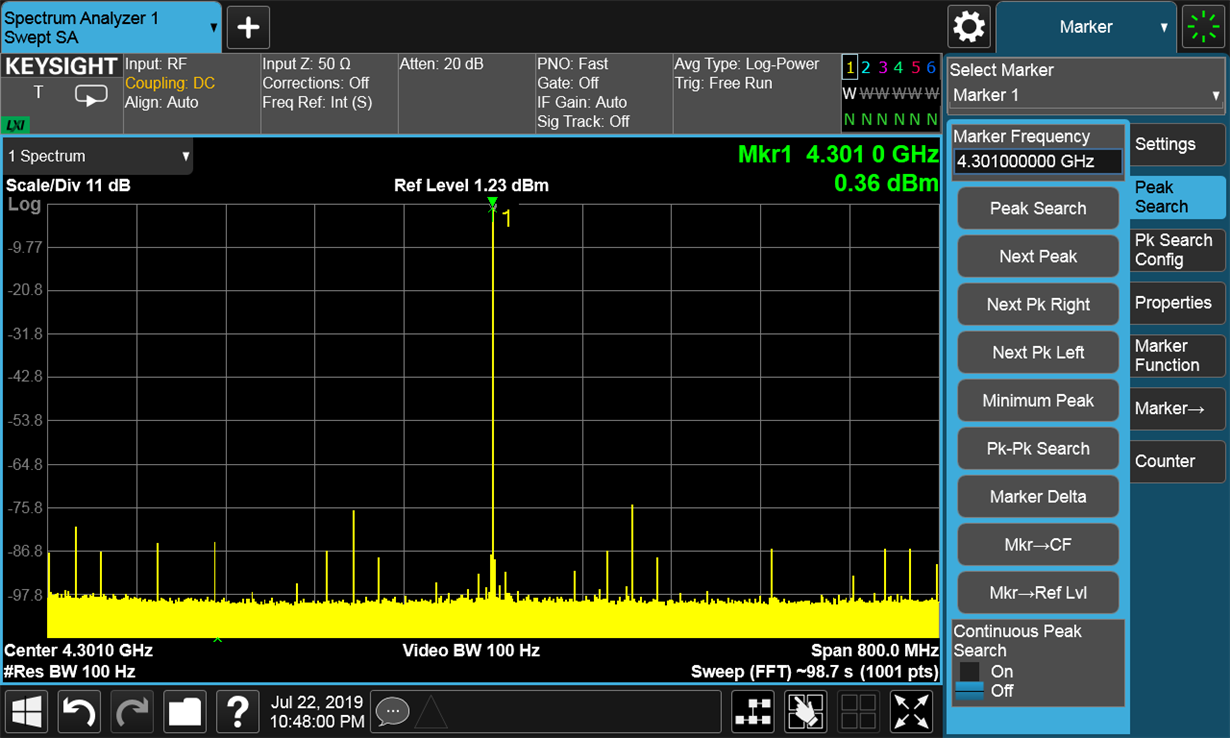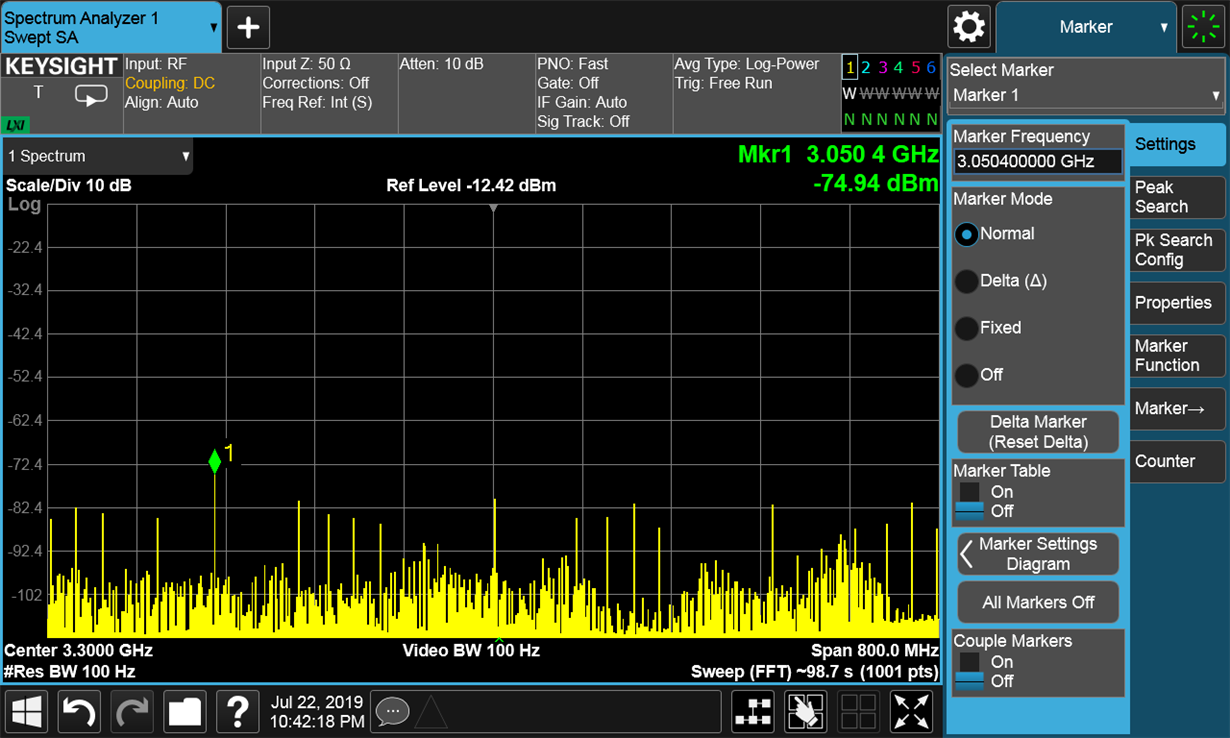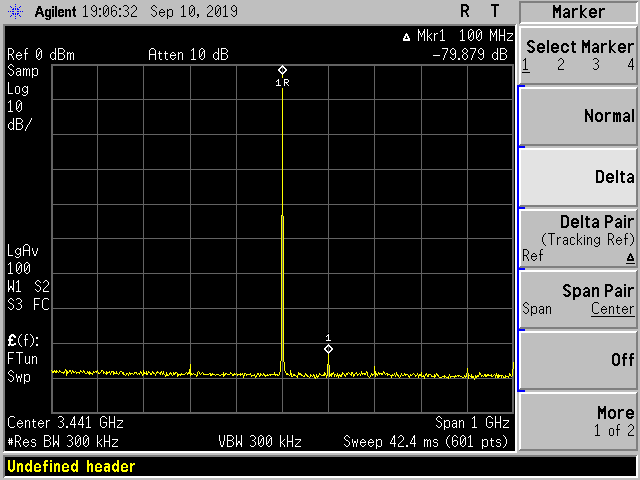Other Parts Discussed in Thread: LMX2594, ,
Hi,
We're evaluating synthesizers for a wideband receiver. It's a superheterodyne receiver with two local oscillators, and the first one needs to tune to whatever frequency in a continuous ~3GHz range or in another continuous, non overlapping 2GHz range. (for example, it might have to tune to any frequency from 0.5 to 2.5 GHz and also from 3 to 6 GHz).
We purchased LMX2594 and LMX2572 EVM's as both of these devices looked very good. We've been working with LMX2594 for a while and we've created an optimization routine with several PFD's and we've been able to reduce close-in spurs to acceptable levels (-80dBc typical) in every frequency we try by adjusting MASH order, PFD, and sometimes MASH seed. We also noted that sometimes changing the output power dramatically reduces some spurs.
The issue comes from far-off spurs, as they are quite nasty. We've measured -50dBc VCO-related spurs 1GHz away from the carrier and similar stuff (in LMX2594) and that's not good for our application. Could be solved with an LO filterbank but we first need to know what to expect in order to design such filter.
We recently got the LMX2572 EVM to check if the far-off spur performance is better, as the charge pump current is lower and Kvco is more linear. Here's a measurement taken from an LMX2572EVM set at 4301 MHz from a 125 MHz reference (the one that comes with the EVM) at 800 MHz span with no optimization. First picture is the carrier, second picture 1GHz away from it:
The register settings are these:
R125 0x7D2288 R124 0x7C0000 R123 0x7B0000 R122 0x7A0000 R121 0x790000 R120 0x780000 R119 0x770000 R118 0x760000 R117 0x750000 R116 0x740000 R115 0x730000 R114 0x727802 R113 0x710000 R112 0x700000 R111 0x6F0000 R110 0x6E0000 R109 0x6D0000 R108 0x6C0000 R107 0x6B0000 R106 0x6A0007 R105 0x694440 R104 0x680000 R103 0x670000 R102 0x660000 R101 0x650000 R100 0x640000 R99 0x630000 R98 0x620000 R97 0x610000 R96 0x600000 R95 0x5F0000 R94 0x5E0000 R93 0x5D0000 R92 0x5C0000 R91 0x5B0000 R90 0x5A0000 R89 0x590000 R88 0x580000 R87 0x570000 R86 0x560000 R85 0x550000 R84 0x540000 R83 0x530000 R82 0x520000 R81 0x510000 R80 0x500000 R79 0x4F0000 R78 0x4E0001 R77 0x4D0000 R76 0x4C000C R75 0x4B0800 R74 0x4A0000 R73 0x49003F R72 0x480001 R71 0x470081 R70 0x46C350 R69 0x450000 R68 0x4403E8 R67 0x430000 R66 0x4201F4 R65 0x410000 R64 0x401388 R63 0x3F0000 R62 0x3E00AF R61 0x3D00A8 R60 0x3C03E8 R59 0x3B0001 R58 0x3A9001 R57 0x390020 R56 0x380000 R55 0x370000 R54 0x360000 R53 0x350000 R52 0x340421 R51 0x330080 R50 0x320080 R49 0x314180 R48 0x3003E0 R47 0x2F0300 R46 0x2E07F0 R45 0x2DCE1F R44 0x2C1FA3 R43 0x2B0198 R42 0x2A0000 R41 0x290000 R40 0x280000 R39 0x2703E8 R38 0x260000 R37 0x250205 R36 0x240022 R35 0x230004 R34 0x220010 R33 0x211E01 R32 0x2005BF R31 0x1FC3E6 R30 0x1E18A6 R29 0x1D0000 R28 0x1C0488 R27 0x1B0002 R26 0x1A0808 R25 0x190624 R24 0x18071A R23 0x17007C R22 0x160001 R21 0x150409 R20 0x144848 R19 0x1327B7 R18 0x120064 R17 0x110096 R16 0x100080 R15 0x0F060E R14 0x0E1810 R13 0x0D4000 R12 0x0C5001 R11 0x0BB018 R10 0x0A10F8 R9 0x090004 R8 0x082000 R7 0x0700B2 R6 0x06C802 R5 0x0530C8 R4 0x040A43 R3 0x030782 R2 0x020500 R1 0x010808 R0 0x00219C
My question is wether this behaviour is normal/expected and what should we expect far off the carrier. Are our spur levels normal?
The EVM has been slightly modified to add an on-board ultra low noise, ultra high PSRR LDO. We basically scratch the soldermask on the back and carefully dead-bug a regulator on the backside and a PI input ferrite-capacitor filter, to have a point of load regulator and avoid unwanted extra noise.




